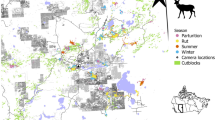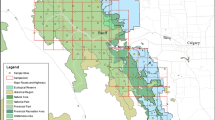Abstract
Increased predator activity along habitat edges (the edge effect) is often documented in the temperate zone, but earlier studies have rarely been able to explicitly test the suggested mechanisms underlining this phenomenon. In this study, we measured the distribution of mammalian predators by scent stations and their main prey (rodents) in four types of landscape elements corresponding to an edge gradient between two habitat types; grassland and forest. We found a contrasting pattern in carnivore activities between years. Whereas carnivores did not exhibit a significant occurrence along the forest–grassland edge in the first year with low prey abundance, they were more likely to be detected along habitat edges in the subsequent year with high prey abundance. Our results do not suggest that the increased activity of carnivores at habitat edges arises as a consequence of predator overflow from higher quality habitat through the edge into lower quality habitat, but showed that most predator species focus their activity specifically to the edge structure. On the other hand, our data do not provide straightforward support for the hypothesis that predator edge preferences are caused by a spatial gradient in carnivores’ main prey—rodents.


Similar content being viewed by others
References
Albrecht T (2004) Edge effect in wetland—arable land boundary determines nesting success of Scarlet Rosefinch (Carpodacus erythrinus) in the Czech Republic. Auk 121:361–371
Anděra M, Horáček I (2005) Poznáváme naše savce. Sobotáles, Praha [In Czech]
Andrén H (1992) Corvid density and nest predation in relation to forest fragmentation: a landscape perspective. Ecology 73:794–804
Andrén H (1995) Effects of landscape composition on predation rates at habitat edges. In: Hansson L, Fahrig L, Merriam G (eds) Mosaic landscapes and ecological processes. Iale studies in landscape ecology. Chapman & Hall, London, pp 225–255
Andrén H, Angelstam P (1988) Elevated predation rates as an edge effect in habitat islands—experimental-evidence. Ecology 69:544–547
Barea-Azcón et al (2006) Surveying carnivores at large spatial scales: a comparison of four broad-applied methods. Biodivers Conserv 16:1213–1230
Bayne EM, Hobson KA (1997) Comparing the effects of landscape fragmentation by forestry and agriculture on predation of artificial nests. Conserv Biol 11:1418–1429
Bider JR (1968) Animal activity in uncontrolled terrestrial communities as determined by a sand transect techniques. Ecol Monogr 38:269–308
Buse A, Good JEG (1993) The effects of conifer forest design and management on abundance and diversity of rove beetles (Coleoptera, Staphylinidae)—implications for conservation. Biol Conserv 64:67–76
Červinka (2010) Distribution of carnivores inside and at the edge of forest habitats. Master thesis, University of South Bohemia
Chalfoun AD, Thompson FR, Ratnaswamy MJ (2002) Nest predators and fragmentation: a review and meta-analysis. Conserv Biol 16:306–318
Crawley MJ (2002) Statistical computing. Wiley, Chichester
Crooks KR (2002) Relative sensitivities of mammalian carnivores to habitat fragmentation. Conserv Biol 16:488–502
Crooks KR, Soulé ME (1999) Mesopredator release and avifaunal extinctions in fragmented systems. Nature 400:563–566
Dijak WD, Thompson FR (2000) Landscape and edge effects on the distribution of mammalian predators in Missouri. J Wildl Manage 64:209–216
Donovan TM, Jones PW, Annand EM, Thompson FR (1997) Variation in local-scale edge effects: mechanism and landscape context. Ecology 78:2064–2075
Fahring L (2003) Effects of habitat fragmentation on biodiversity. Annu Rev Ecol Evol S 34:487–515
Flashpohler DJ, Temple SA, Rosenfield RN (2001) Species-specific edge effects on nest success and breeding bird density in a forested landscape. Ecol Appl 11:32–46
Gates JE, Gysel LW (1978) Avian nest dispersion and fledging outcome in field–forest edges. Ecology 59:871–873
Gehring TM, Swihart RK (2003) Body size, niche breadth, and ecologically scaled responses to habitat fragmentation: mammalian predators in an agricultural landscape. Biol Conserv 109:283–295
Genovesi P, Secchi M, Boitani L (1996) Diet of stone martens: an example of ecological flexibility. J Zool 238:545–555
Goszczyński J (1986) Diet of foxes and martens in central Poland. Acta Theriol 31:491–506
Heske EJ (1995) Mammalian abundances on forest–farm edges versus forest interiors in southern Illinois: is there an edge effect? J Mammal 76:562–568
Hilty JA, Merenlender AM (2004) Use of riparian corridors and vineyards by mammalian predators in Northern California. Conserv Biol 18:26–135
Huhta E, Jokimaki J, Helle P (1998) Predation on artificial nests in a forest dominated landscape—the effect on nest type, patch size and edge structure. Ecography 21:464–471
Jędrzejewski W, Jędrzejewska B (1993) Predation on rodents in Bialowieza primeval forest, Poland. Ecography 16:47–64
Jędrzejewska W, Jędrzejewski B (1998) Predation in vertebrate communities, the Białowieza primeval forest as a case study. Springer, Berlin
Korpimäki E, Norrdahl K (1989) Avian predation on mustelids in Europe 1: occurrence and effects on body size variation and life traits. Oikos 55:205–215
Korpimäki E, Norrdahl K, Rinta-Jaskari T (1991) Responses of stoats and least weasels to fluctuating food abundances: is the low phase of the vole cycle due to mustelid predation? Oecologia 88:552–561
Korpimäki E, Norrdahl K, Huitu O, Klemola T (2005) Predator-induced synchrony in population oscillations of coexisting small mammal species. Proc R Soc B 272:193–202
Lanszki J, Heltai M (2007) Diet of the weasel in Hungary. Folia Zool 56:109–112
Lanszki J, Zalewski A, Horváth G (2007) Comparison of red fox Vulpes vulpes and pine marten Martes martes food habits in a deciduous forest in Hungary. Wildl Biol 13:258–271
Larivière S (2003) Edge effects, predator movements, and travel-lane paradox. Wildl Soc B 31:315–320
Larivière S, Messier F (2000) Habitat selection and use of edges striped skunks in the Canadian prairies. Can J Zool 78:366–372
Lázaro A, Mark S, Olesen JM (2005) Bird-made fruit orchards in northern Europe: nestedness and network properties. Oikos 110:321–329
Lidicker WZ Jr (1999) Responses of mammals to habitat edges: an overview. Landscape Ecol 14:333–343
Linhart SB, Knowlton FF (1975) Determining the relative abundance of coyotes by scent station lines. Wildl Soc B 3:119–124
Malt J, Lank D (2007) Temporal dynamics of edge effects on nest predation risk for the marbled murrelet. Biol Conserv 140:160–173
Martinoli A, Preatoni DG, Chiarenzi B, Wauters LA, Tosiet G (2001) Diet of stoats (Mustela erminea) in an Alpine habitat: the importance of fruit consumption in summer. Acta Oecol 22:45–53
Pasitschniak-Arts M, Messier F (1995) Risk of predation on waterfowl nests in the Canadian prairies: effects of habitat edges and agricultural practices. Oikos 73:347–355
Pita R, Mira A, Moreira F, Morgado R, Beja P (2009) Influence of landscape characteristics on carnivore diversity and abundance in Mediterranean farmland. Agr Ecosyst Environ 132:57–65
Ratti JT, Reese KP (1988) Preliminary test of the ecological trap hypothesis. J Wildife Manage 52:484–491
R Development Core Team (2008). R: a language and environment for statistical computing. Vienna, Austria. Available at http://www.Rproject.org
Ries L, Sisk TD (2004) A predictive model of edge effects. Ecology 85:2917–2926
Ries L, Fletcher RJ Jr, Battin J, Sisk TD (2004) Ecological responses to ecological edges: mechanism, models, and variability explained. Annu Rev Ecol Evol S 35:491–522
Šálek M (2009) Ecology of mustelids in Central European landscape. PhD dissertation, University of South Bohemia
Šálek M, Kreisinger J, Sedláček F, Albrecht T (2009) Corridor vs. hayfield matrix use by mammalian predators in an agricultural landscape. Agr Ecosyst Environ 143:8–13
Šálek M, Kreisinger J, Sedláček F, Albrecht T (2010) Do prey densities determine preferences of mammalian predators for habitat edges in an agricultural landscape? Landscape Urban Plann (in press)
Schmidt KA (2003) Nest predation and population declines in Illinois songbirds: a case for mesopredator effects. Conserv Biol 17:1141–1150
Storch I, Woitke E, Krieger S (2005) Landscape-scale edge effect in predation risk in forest–farmland mosaics of central Europe. Landscape Ecol 20:927–940
St-Pierre C, Oullet J, Crête M (2006) Do competitive intraguild interactions affect space and habitat use by small carnivores in a forested landscape? Ecography 29:487–496
Virgós E, Telería JL, Santos T (2002) A comparison on the response of forest fragmentation by medium-sized Iberian carnivores in central Spain. Biodivers Conserv 11:1063–1079
Wilcove DS (1985) Nest predation in forest tracts and the decline of migratory songbirds. Ecology 66:1211–1214
Winter M, Johnson DH, Shaffer JA, Donovan TM, Svedarsky WD (2006) Patch size and landscape effects on density and nesting success of grassland birds. J Wildl Manage 70:158–172
Zub K, Sönnichsen L, Szafrańska PA (2008) Habitat requirements of weasels Mustela nivalis constrain their impact on prey populations in complex ecosystems of the temperate zone. Oecologia 157:571–582
Zub K, Szafrańska PA, Konarzewski M, Redman P, Speakman JR (2009) Trade-offs between activity and thermoregulation in a small carnivore, the least weasel Mustela nivalis. Proc R Soc B 276:1921–192
Acknowledgements
We thank Šálek M.E., Mrštný L., Wonke O., and Kukač P. for their help with field work. This study was supported by the grant of the Czech Ministry of Education (MŠMT 6007665801, no. 1P05OC078 and no. 0021620828), the Research Aim of the Institute of Systems Biology and Ecology AV0Z60870520 and AV0Z60930519, Internal grant agency of Czech University of Environmental Sciences CIGA 42110/1313/3108, and the Grant Agency of the CR GAČR 524/06/0687. T. A. and J. K. were partially supported by the Research Centrum project no. LC06073 and the grant of the Czech Ministry of Environment (VAV sp2d3-60-08).
Author information
Authors and Affiliations
Corresponding author
Additional information
Communicated by C. Gortázar
Electronic supplementary material
Below is the link to the electronic supplementary material.
ESM 1
Visits of individual species to particular habitats. In total, 120 scent stations were randomly distributed within four habitat types (southern Bohemia in 2006 and 2007) (DOC 44 kb)
ESM 2
Numbers of rodents captured along edge gradients in southern Bohemia, 2006 and 2007. In each habitat type, eight lines of 35 traps were installed (DOC 29 kb)
Rights and permissions
About this article
Cite this article
Svobodová, J., Kreisinger, J., Šálek, M. et al. Testing mechanistic explanations for mammalian predator responses to habitat edges. Eur J Wildl Res 57, 467–474 (2011). https://doi.org/10.1007/s10344-010-0455-0
Received:
Revised:
Accepted:
Published:
Issue Date:
DOI: https://doi.org/10.1007/s10344-010-0455-0




